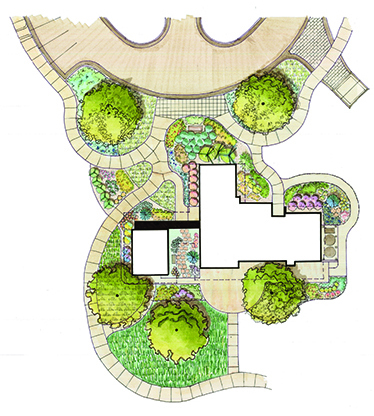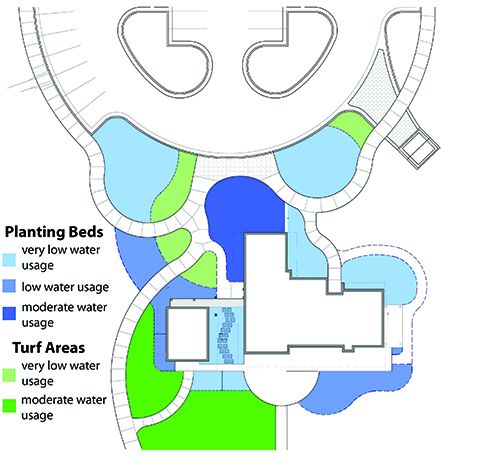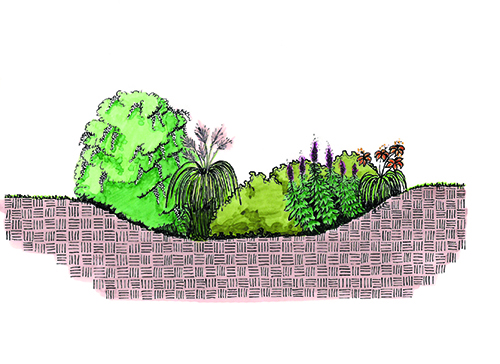Xeriscape Demonstration Garden: Edmond, Oklahoma
What Is Xeriscape Gardening?
Simply put, XERISCAPE (pronounced zir’-i-skap) is creative, attractive landscaping that saves water. XERISCAPE is not rocks and cactus or yucca, or dull colors and the complete elimination of turfgrasses. The word XERISCAPE, (from the Greek Xeros meaning dry and scape from landscape) was coined by the Denver Water Department and has become a commonly used term in the landscape industry, particularly in drier areas of the country.
7 Xeriscape Principles
- Planning and Design
- Soil Improvement
- Practical Turf
- Plant Selection and Placement
- Efficient Irrigation
- Use of Mulches
- Appropriate Maintenance
Why Xeriscape in Edmond?
Though the Edmond area receives on average a fair amount of annual precipitation, it doesn’t always fall during the hot summer months when many plants need it. Coupled with significant growth in the city’s population, the current systems are unable to meet the demands for water use during peak summer months, forcing the city to occasionally implement mandatory water rationing. During the summer months, as much as 50% of the total treated water supply in Edmond is used to irrigate landscapes, and on hot, dry days that figure can reach 80%! The XERISCAPE concept stresses the use of Xeric principles to establish a landscape that is colorful, attractive and looks lush, but requires far less water and maintenance than conventional landscaping. During extended droughts or water shortages, the landscape is designed, constructed, and maintained to be more water efficient and in balance with the natural rainfall, while continuing to flourish and hold its beauty.
Principles of Xeriscape Gardening
Start with a Good Design
Many people create their own designs with excellent results. You may want to have a professional check your plans, or complete the entire design. Begin with a sketch (1/4 inch = 1 foot), showing your home and property. Consider slopes, soils, aspect (direction of slope), drainage, limited areas of turf, privacy areas, play areas, etc. Plants need to complement the site and structure, as well as look great and save water.

Xeriscape Garden
Bickham-Rudkin Park
33rd & Rankin
Edmond, OK
Improve the Soil
For best results, add 3 to 5 cubic yards of organic material per 1,000 square feet of planting area and rototill to 6 inches deep. If you like, the Oklahoma County Extension Office will help have your soil analyzed.
Practical Turf Areas
Turf is important to the landscape, but it can have a significant water requirement. A reduction in the total amount of traditional lawn, targeting practical and essential areas based on function and aesthetics, will have a corresponding reduction in water use. Selecting the right species is also very important. Turfgrasses vary in their need for irrigation. Common turfgrass species used in Oklahoma in order of water needs from highest to lowest include: cool-season grasses (tall fescue, Kentucky bluegrass, and ryegrass), hybrid bermudagrass and zoysiagrass, common bermudagrass, and buffalograss. In most cases cool-season grasses are not recommended for full sun areas; however, they may be an appropriate selection for shady areas.
Use Mulches Effectively
Mulch covers soil, saves moisture, reduces weed growth, and adds interest. It should be spread about 3 inches deep over soil. Avoid using solid sheet plastic. Mulch areas cost about the same as turf and look best when plants are used to cover a major part of the mulched area. Nursery people can tell you more about mulch.
Use Irrigation Effectively and Efficiently
Plan to irrigate turf areas separately from other plantings. Use a zone irrigation system that groups the plants according to their water requirements. Drip irrigation can help save water and reduce weed growth.
Choose Low Water Demanding Plants
Scores of species are available. Colorful flowers, trees, shrubs, and attractive ground covers will complement your Xeriscape. Turf requiring less water is also available.
Practice Good Maintenance
Maintenance preserves the intended beauty of the landscape, and it saves water. Proper mowing height, fertilizing, pruning, and weeding all help promote a healthy garden. Fine tune your irrigation system, and follow recommended lawn watering guidelines.
What are the Water Use Zones?
The Bickham-Rudkin Park Xeriscape Garden incorporates three water use zones. The very low zone provides for a considerable savings in water use and maintenance compared to a traditional irrigated landscape. A low water zone provides reasonable water savings. A moderate water zone is the highest use zone in the garden. Irrigation is applied at a rate that allows for optimum and luxurious plant growth, while still employing the concepts of XERISCAPE. The map in this brochure shows the zones in our garden.

Xeriscape at Bickham-Rudkin Park
The Xeriscape garden at Bickham-Rudkin park was designed to demonstrate effective water management strategies within a residential landscape. Those strategies include water conservation (Xeriscape), rain water capture for use in the landscape, reduced volume and rate of stormwater runoff, and improved water quality.
Additional Water Management Applications
Rain Gardens
Rain gardens are shallow depressions planted with native and other plants  that soak up rainwater or melted snow from your rooftop, driveway, and lawn. These
select plants can withstand both wet and dry conditions. Rain gardens allow water
to infiltrate into the soil rather than becoming runoff. Well drained soils are required
for rain gardens, and must drain in less than 48 hours. If native soils do not meet
this requirement, they should be replaced or amended to a depth of 3 to 4 feet. In
some applications, a subsurface drainage pipe is necessary.
that soak up rainwater or melted snow from your rooftop, driveway, and lawn. These
select plants can withstand both wet and dry conditions. Rain gardens allow water
to infiltrate into the soil rather than becoming runoff. Well drained soils are required
for rain gardens, and must drain in less than 48 hours. If native soils do not meet
this requirement, they should be replaced or amended to a depth of 3 to 4 feet. In
some applications, a subsurface drainage pipe is necessary.
Rain water Cisterns
Rain water can easily be collected, stored, and used as a supplemental water source. Depending on one’s needs, rain water can be stored in large quantities in cisterns or in small quantities in a rain barrel. During a 1-inch rain event, 500 to 600 gallons of rain water can be collected for every 1,000 square feet of roof area.
Participants & Sponsors
Xeriscape Committee:
- David Hillock
- Michael Holmes
- Earl London
- Ashley Stringer
- Ilene Harrington Olson
- Fred Rice
- Steve Commons
- Ryan Ochsner
- Carrie Tomlinson
Organization Sponsors:
- City of Edmond
- Edmond Water Resources Department
- Edmond Drainage Utility
- Oklahoma Cooperative Extension Service
- Department of Horticulture & Landscape Architecture
- Oklahoma State University
Donations:
- Hunter Irrigation
- Tulsa Grass and Sod Farm
- John Fluitt Landscaping
Volunteers:
Oklahoma County Master Gardener
David Hillock
Master Gardener Coordinator
Department of Horticulture and Landscape Architecture
Michael Holmes
Program Director and Professor Landscape Architecture
Department of Horticulture and Landscape Architecture
